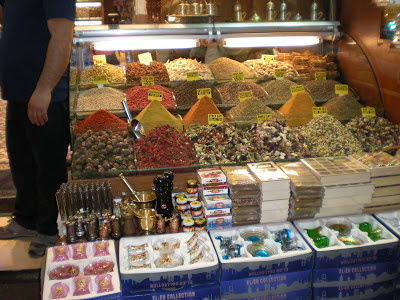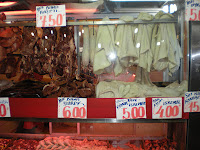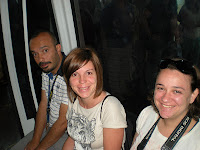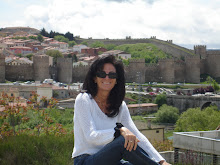TURKEY
WHERE THE WEST MEETS THE EAST
WHERE THE WEST MEETS THE EAST
8 Days Magic Tour of Turkey
- Istanbul
- Cappodocia
- Konya
- Pammukale and more.....
 |
| The Bosforo is what brings the ASIA and EUROPE together... two sides - ASIA/EUROPE |
  | ||
| JANEREK!!! Yea.. my favorite fruit. Dip it with some salt and eat.. Salty Sour |
 |
| FRESH FRUITS.... |
 |
| Naturally Organic |
ISTANBUL - over 17 million people living in the Asian and European continential city of Istanbul. Founded 600 years BC it was originally known as Constantinople and served as the capital in 300BC for 4 empires - Roman Empire, Byzantine Empire, Latin Empire and Ottoman Empire
The Asian part of Turkey is called ANATOLIA.
 |

STREET SIGNS OF ISTANBUL
Istanbul's strategic position on the Silk Route fostered itself as an important trading city til today as a main trading city between East and West.
 |
| BOAT RIDE ON THE BOSFORO |
of Mamara lies one of the busiest
waterways in the world -
the Bosforo - which separates
East from the West - Asia and Europe.
55,000 boats travel on the Bosforo a year. For each 12 hours they can only go one way and then the next 12 hours the other way.
Turkey signed the International Treaty allowing ships to travel the waterways for free. However they make money from the drayage, docking and other shipping services.
The smells and colors of the Spice market were quite intense.. So many different products -look and feel. Walking thru this Spice Market takes you back in time to when many passed through Istanbul on the Silk Route selling and trading with much rigor and excitement as today.
The nuts and dried fruit were ample... prices are the same as in the West if not more.
55,000 boats travel on the Bosforo a year. For each 12 hours they can only go one way and then the next 12 hours the other way.
Turkey signed the International Treaty allowing ships to travel the waterways for free. However they make money from the drayage, docking and other shipping services.
12 million people visit Istanbul a year making it the 5th most traveled city in the world.
Istanbul is currently competing for the 2020 Olympics.
THE SPICE MARKET
The smells and colors of the Spice market were quite intense.. So many different products -look and feel. Walking thru this Spice Market takes you back in time to when many passed through Istanbul on the Silk Route selling and trading with much rigor and excitement as today.
The nuts and dried fruit were ample... prices are the same as in the West if not more.
SULTAN AHMET CAMII MOSQUE
Built in 1906 the Blue Mosque is known for its |
| THE BLUE MOSQUE- the largest Mosque in Istanbul |
thousands of blue tiles.
(Called Sultanahmet Camii in Turkish)
With over 20,000 tiles and 200 stained glass windows with a mixture of both Ottoman and Byzantine style. Commissioned by19 year old Sultan Ahmet - it took 7 years to complete.
St Sophia was originally a Church then later
converted to a mosque. During the reign of the Ottoman Turks they converted the Cathedral to a church and it is currently a museum.
Built in the 5th century until the 16th century it was a Basilica. It was the largest cathedral for over 1000 years until the Cathedral is Sevilla in Spain was finished in 1520.
A popular drink with the street vendors
is fresh Pomegranate

Dating back from the 6th century BC, Cappadocia in Eastern Anatolya is a natural heritage wonder of 1000 m high volcanic peaks. 9 million years ago sedimentary rocks were formed from erupted volcanos.
 The rocks of Cappadocia near Göreme eroded into hundreds of spectacular pillars and minaret-like forms. People of the villages at the heart of the Cappadocia Region carved out houses, churches and monasteries from the soft rocks of volcanic deposits. Göreme became a monastic centre in 300—1200 AD. There are over 102 churches carved out in the caves with the walls painted with depicted scenes of religious events.
The rocks of Cappadocia near Göreme eroded into hundreds of spectacular pillars and minaret-like forms. People of the villages at the heart of the Cappadocia Region carved out houses, churches and monasteries from the soft rocks of volcanic deposits. Göreme became a monastic centre in 300—1200 AD. There are over 102 churches carved out in the caves with the walls painted with depicted scenes of religious events.
 The caves stay at 17 degree Celsius the entire year. Even though there is snow during the winter the cave are not cold and in the hot summer stay cool inside - which is how they survived living in the caves.
The caves stay at 17 degree Celsius the entire year. Even though there is snow during the winter the cave are not cold and in the hot summer stay cool inside - which is how they survived living in the caves. 
300 BC Persecuted Christians fled here to practice their religion freely. They hid and lived in these caves they carved out of the Volcanic rocks and settled there til the 15th century when there was a massive earthquake.
They took everything with them including the graves.
What is left is the caves carved out where they lived and the paintings they made on walls inside their "church".
The government gave his the cave and land for free.
 Then they are threaded through the spools to separate them.
Then they are threaded through the spools to separate them.
Kelvin from Hong Kong said his mom cooks the worms in a special sauce for lunch and they are delicious.
Lunch or a dress?

 The amphitheater was built after the destructive earthquake destroyed the city in 60 BC. The theatre was built in 17BC. It seats 15000 which means there was over 150000 inhabitants in the city. They way they determine population is that all theaters are built for 10% of the population.
The amphitheater was built after the destructive earthquake destroyed the city in 60 BC. The theatre was built in 17BC. It seats 15000 which means there was over 150000 inhabitants in the city. They way they determine population is that all theaters are built for 10% of the population.
The Hellenistic city was built with streets running parallel or perpendicular to the main street
The white cliffs of Pamukkale were formed when a spring with a high content of dissolved calcium bicarbonate cascaded over the edge of the cliff, which cooled and hardened leaving calcium deposits. This formed into natural pools, shelves and ridges. It's called "COTTON CASTLE" because of the cascades of white naturally formed waterfalls...
 Pamukkale is invaded by visitors not only for it's beauty but for the therapeutic qualities of the water, celebrated since antiquity as being a health cure
Pamukkale is invaded by visitors not only for it's beauty but for the therapeutic qualities of the water, celebrated since antiquity as being a health cure
Pamukkale's terraces are made of travertine, a sedimentary rock deposited by water from the hot springs. ancient Greco-Roman and Byzantine city of Hierapolis was built on top of the white "castle" which is in total about 2,700 metres
 Mark Anthony - ruler of Ancient Egypt gave the city of Hiercopolis to his wife Cleopatra as a gift. She spent 6 months there in the thermal baths one year for health purposes.
Mark Anthony - ruler of Ancient Egypt gave the city of Hiercopolis to his wife Cleopatra as a gift. She spent 6 months there in the thermal baths one year for health purposes.
 You can pay to swim in the ancient pool for 25Lira which is about $12. It's therapeutic waters are set to heal many ailments.
You can pay to swim in the ancient pool for 25Lira which is about $12. It's therapeutic waters are set to heal many ailments.
 During the Roman Empire period, Hierapolis was a health centre. Thousand so people were coming to the Baths for healing. At the time there was more than 15 natural thermal baths.
During the Roman Empire period, Hierapolis was a health centre. Thousand so people were coming to the Baths for healing. At the time there was more than 15 natural thermal baths.
Today’s Antique Pool was shaped by the earthquake which happened in A.D. VII. Century. Many of the Roman/Greek columns fell into the spring during the earthquake in VII. Century A.D. They are still there today making for an impressive natural rock look in the pool.

PERGAMON - Ancient Greek/Roman city near the Aegean Sea.
 It became the capital of the Kindgdom of Pergamon during the Hellenistic period in 281–133 BC. Pergamon is mentioned in the Book of Revelations in the bible as one of the seven churches in Asia.
It became the capital of the Kindgdom of Pergamon during the Hellenistic period in 281–133 BC. Pergamon is mentioned in the Book of Revelations in the bible as one of the seven churches in Asia.
The Greeks built an amphitheater on an incline with a view to the countryside.
The Romans built an amphitheather on a flat surface and the stage was built up high to block any distractions of the view.
This theater was a combinations of the two. It was first built by the Greeks and then later rebuilt after its destruction by the Romans.
 The entire great altar of Pergamon ( called Apollos Temple) was taken by the Germans to Berlin where they have it built in a museum .
The entire great altar of Pergamon ( called Apollos Temple) was taken by the Germans to Berlin where they have it built in a museum .
 Pergamon was briefly the capital of the Roman province of Asia, before the capital was transferred to Ephesus.The Hellenistic Theater with a seating capacity of 10,000. This had the steepest seating of any known theater in the ancient world.
Pergamon was briefly the capital of the Roman province of Asia, before the capital was transferred to Ephesus.The Hellenistic Theater with a seating capacity of 10,000. This had the steepest seating of any known theater in the ancient world.
The 40 minute ferry ride crossing from the Asia side to the Asia side to get back to Istanbul. The ride saves over 3 hours on the road.
Beautiful sunset.......slight breeze... and the end of a lovely trip to exotic exciting Istanbul.. where the East meets the West.
.
A popular drink with the street vendors
is fresh Pomegranate
 |
| Mustafa |
 |
| Onur & Zeinap |
 |

 |
| Dinner on the Bosforo with our friends in Istanbul |
 |
| Fresh - strawberries, cherries, janerek, nispero and sweets |
 |
| ANKARA - capital of Istanbul - 5 million people live here. It is not a tourist town. Very local. |
Ankara is a very old city with various Hittite, Phrygian, Hellenistic, Roman, Byzantine, and Ottoman archaeological sites. It is is the 2nd largest city in Turkey

FLAVORS AT A LOCAL MARKET
 |
| Grape Leaves |
 |
| Lunch with the "TRAVELING GROUP".... |
 |
| AND MORE... |
CAPPADOCIA
Dating back from the 6th century BC, Cappadocia in Eastern Anatolya is a natural heritage wonder of 1000 m high volcanic peaks. 9 million years ago sedimentary rocks were formed from erupted volcanos.
 The rocks of Cappadocia near Göreme eroded into hundreds of spectacular pillars and minaret-like forms. People of the villages at the heart of the Cappadocia Region carved out houses, churches and monasteries from the soft rocks of volcanic deposits. Göreme became a monastic centre in 300—1200 AD. There are over 102 churches carved out in the caves with the walls painted with depicted scenes of religious events.
The rocks of Cappadocia near Göreme eroded into hundreds of spectacular pillars and minaret-like forms. People of the villages at the heart of the Cappadocia Region carved out houses, churches and monasteries from the soft rocks of volcanic deposits. Göreme became a monastic centre in 300—1200 AD. There are over 102 churches carved out in the caves with the walls painted with depicted scenes of religious events.
 The caves stay at 17 degree Celsius the entire year. Even though there is snow during the winter the cave are not cold and in the hot summer stay cool inside - which is how they survived living in the caves.
The caves stay at 17 degree Celsius the entire year. Even though there is snow during the winter the cave are not cold and in the hot summer stay cool inside - which is how they survived living in the caves. 
300 BC Persecuted Christians fled here to practice their religion freely. They hid and lived in these caves they carved out of the Volcanic rocks and settled there til the 15th century when there was a massive earthquake.
They took everything with them including the graves.
What is left is the caves carved out where they lived and the paintings they made on walls inside their "church".
All the holes in the rocks are homes where people lived until the 1500s when an earthquake erupted and the people abandoned the area. Christian persecuted for their beliefs came to this area to hide and practice their faith without punishment.
 |
| Duplex cave with an upstairs and a downstairs. The people took everything with them when they abandoned the area. |
 |
| Our guides - Ahmed and Mehmat! Thanks! |
 |
| Wong - Kelvin from Hong Kong. I hope he didn't forget anything when he went back home! |
LOCAL FLAVORS AT THE MARKET
 |
| Bob's second love - Tomatoes - ( or maybe his first?) |
 |
| The only inhabited cave - handed down from the mans great great grandfather. |
CARPET SHOWROOM
 |
| Handmade carpets - double knotted |
 |
| Takes 6-8 months to finish 1 carpet. 1200 workers - 7000 carpets - |
How silk is made. Silk worms without the butterfly are put into hot boiling water. Over 24 km long of thousands of strands are pulled out of the silk worm.
 Then they are threaded through the spools to separate them.
Then they are threaded through the spools to separate them.Kelvin from Hong Kong said his mom cooks the worms in a special sauce for lunch and they are delicious.
 |
| Voila - the end results of silk worms - Beautiful colorful carpets - priceless! |
 |
| Over 2000 people go up daily in hot air ballons over the rock formations. E140 a person for 50 minutes. |
HIERAPOLIS - GREEK/ROMAN CITY - NOW A HERITAGE SITE

 The amphitheater was built after the destructive earthquake destroyed the city in 60 BC. The theatre was built in 17BC. It seats 15000 which means there was over 150000 inhabitants in the city. They way they determine population is that all theaters are built for 10% of the population.
The amphitheater was built after the destructive earthquake destroyed the city in 60 BC. The theatre was built in 17BC. It seats 15000 which means there was over 150000 inhabitants in the city. They way they determine population is that all theaters are built for 10% of the population.The Hellenistic city was built with streets running parallel or perpendicular to the main street
The white cliffs of Pamukkale were formed when a spring with a high content of dissolved calcium bicarbonate cascaded over the edge of the cliff, which cooled and hardened leaving calcium deposits. This formed into natural pools, shelves and ridges. It's called "COTTON CASTLE" because of the cascades of white naturally formed waterfalls...

 Pamukkale is invaded by visitors not only for it's beauty but for the therapeutic qualities of the water, celebrated since antiquity as being a health cure
Pamukkale is invaded by visitors not only for it's beauty but for the therapeutic qualities of the water, celebrated since antiquity as being a health cure Pamukkale's terraces are made of travertine, a sedimentary rock deposited by water from the hot springs. ancient Greco-Roman and Byzantine city of Hierapolis was built on top of the white "castle" which is in total about 2,700 metres

The waters are warm and full of calcium with a sandy feeling. To see it is truly a natural wonder.
CLEOPATRA POOL
 Mark Anthony - ruler of Ancient Egypt gave the city of Hiercopolis to his wife Cleopatra as a gift. She spent 6 months there in the thermal baths one year for health purposes.
Mark Anthony - ruler of Ancient Egypt gave the city of Hiercopolis to his wife Cleopatra as a gift. She spent 6 months there in the thermal baths one year for health purposes. You can pay to swim in the ancient pool for 25Lira which is about $12. It's therapeutic waters are set to heal many ailments.
You can pay to swim in the ancient pool for 25Lira which is about $12. It's therapeutic waters are set to heal many ailments.  During the Roman Empire period, Hierapolis was a health centre. Thousand so people were coming to the Baths for healing. At the time there was more than 15 natural thermal baths.
During the Roman Empire period, Hierapolis was a health centre. Thousand so people were coming to the Baths for healing. At the time there was more than 15 natural thermal baths. Today’s Antique Pool was shaped by the earthquake which happened in A.D. VII. Century. Many of the Roman/Greek columns fell into the spring during the earthquake in VII. Century A.D. They are still there today making for an impressive natural rock look in the pool.

Hierapolis became a healing centre where doctors used the hot thermal springs as a treatment for their patients. The city began issuing bronze coins in the 2nd century BC. These coins give the name Hieropolis (town of the temple Hieron). This name eventually changed into Hierapolis ( which means HOLY CITY)
 |
| CEMETERY |
 |
| Beer Break! Good laughs and good company!
LEATHER FASHION SHOW
|
 |
| Our own personal model - ENRIQUE! A new career for him! |
 |
| GO ENRIQUE and SUSANA!! |
AEGEAN SEA
 |
| THE END IS NEAR..... |
 |
| OUR LAST FEW HOURS TOGETHER |
 |
| CABLE RIDE - TO PERGAMON |
PERGAMON - Ancient Greek/Roman city near the Aegean Sea.
 It became the capital of the Kindgdom of Pergamon during the Hellenistic period in 281–133 BC. Pergamon is mentioned in the Book of Revelations in the bible as one of the seven churches in Asia.
It became the capital of the Kindgdom of Pergamon during the Hellenistic period in 281–133 BC. Pergamon is mentioned in the Book of Revelations in the bible as one of the seven churches in Asia.The Greeks built an amphitheater on an incline with a view to the countryside.
The Romans built an amphitheather on a flat surface and the stage was built up high to block any distractions of the view.
This theater was a combinations of the two. It was first built by the Greeks and then later rebuilt after its destruction by the Romans.
 The entire great altar of Pergamon ( called Apollos Temple) was taken by the Germans to Berlin where they have it built in a museum .
The entire great altar of Pergamon ( called Apollos Temple) was taken by the Germans to Berlin where they have it built in a museum . |
| VERTICAL SLOPE!! |
 Pergamon was briefly the capital of the Roman province of Asia, before the capital was transferred to Ephesus.The Hellenistic Theater with a seating capacity of 10,000. This had the steepest seating of any known theater in the ancient world.
Pergamon was briefly the capital of the Roman province of Asia, before the capital was transferred to Ephesus.The Hellenistic Theater with a seating capacity of 10,000. This had the steepest seating of any known theater in the ancient world.
A combination of a Greek Temple and a Roman temple.
 |
| HAIL ROBERT! |
The 40 minute ferry ride crossing from the Asia side to the Asia side to get back to Istanbul. The ride saves over 3 hours on the road.
Beautiful sunset.......slight breeze... and the end of a lovely trip to exotic exciting Istanbul.. where the East meets the West.
.
A part of Turkey we took back with us..... handmade carpet from Kaysari....



 7:51 PM
7:51 PM
 2011 ROAD TRIP
2011 ROAD TRIP








































































































































 Posted in:
Posted in: 





5 comments:
ole ole ole...!!!
saludos
Celia y Martín
Saludos amigos.. tenemos un buen recuerde... bestios - echo de menos...
Jas, you do EVERYTHING so well.. This could be in a travel magazine!
What a very beautiful trip. Travel is amazing.
Oh and you are a super photographer!!
Xoxo Flo
Dear Jasmine and Bob:
Great pictures, love the scarves . . . but how come Bob didn't have one? Hmmmmmmmmmmmm.
And you guys really fit in at the Bazaar !!
As always, many thanks for sharing.
Love,
Joel
____
Wow Jazz, nice post. Always interesting to see how others live and the cost of living there.
Amazing to see the hot air balloons enmass... also interesting to know it's that many. When my eyes/thyroid was bad over the past several years, I had an eye doctor in Toronto (for surgery) and my endocronolgist in St J's NL. (Neither had met ever before of course)UNBELIEVABLE to conceive that they crossed paths while on vacation,took a ride in a(one of 2000 daily you say) hot air balloon over Turkey- while on separate vacations,realized they were both from Canada, chatted,and lo and behold, had ME - a patient from NL- in Common! What are the lottery odds on that! xxoo enjoy your day beauty
Post a Comment